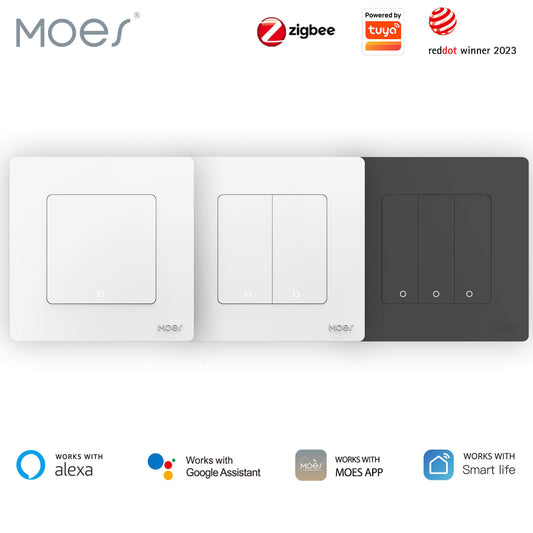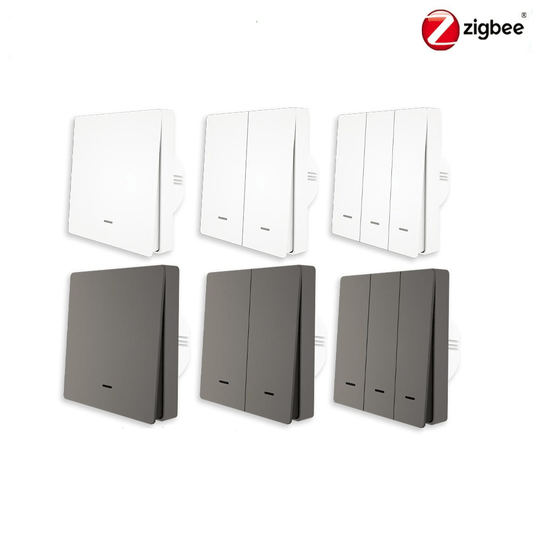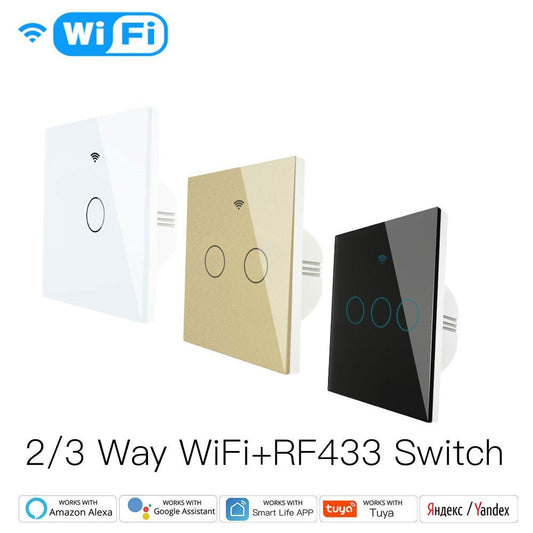Radio Frequency (RF) communication is a widely adopted wireless data transmission technology. Among the available frequency bands, 433 MHz stands out for its stability and low power consumption.
433 MHz is a popular choice in scenarios such as remote controls, home automation systems, and wireless sensor networks. Today, many companies offer smart devices that support the 433 MHz band.
So, how does 433 MHz technology work? And what specific advantages can it bring to smart home environments? Let’s explore the details.

Fundamentals of RF Communication
RF (Radio Frequency) communication refers to the transmission of data through the air or free space using electromagnetic waves.
Information is transmitted and received via antennas after being encoded through the modulation of properties such as amplitude, frequency, or phase.
The 433 MHz band falls within the Ultra High Frequency (UHF) range, which spans from 300 MHz to 3 GHz.
As one of the license-free Industrial, Scientific, and Medical (ISM) frequency bands approved in many countries, 433 MHz enables low-data-rate, short-range wireless communication without the need for regulatory licensing.
Relationship Between Wavelength and Frequency
According to the physical formula:
λ = c / f
Where:
- λ represents the wavelength (in meters)
- c is the speed of light, approximately 3 × 10⁸ meters per second
- f denotes the frequency (in hertz)
At 433 MHz, the corresponding wavelength is approximately 0.69 meters. This wavelength significantly influences the signal’s penetration ability and propagation characteristics.
Advantages of 433 MHz Wireless Communication Technology
Cost-Effectiveness
433 MHz modules feature a simple hardware design, typically requiring only a few components to enable transmission and reception, without the need for complex processing chips or communication stacks.
This results in a low bill of materials (BOM) cost and a low manufacturing barrier. Compared to alternatives such as ZigBee, Wi-Fi, or LoRa, 433 MHz is particularly suitable for mid- to low-end consumer applications like remote control switches and wireless doorbells.
Long-Range Transmission
With a relatively low carrier frequency, 433 MHz offers excellent diffraction and propagation characteristics.
In open areas, communication ranges can exceed 100 meters. When paired with high-gain antennas or signal amplifiers, the range can extend to several hundred meters.
Strong Penetration Capability
Compared to the 2.4 GHz frequency used by ZigBee and Wi-Fi, 433 MHz signals have superior ability to penetrate through walls, cement, and metal structures.
For instance, in a residential building with reinforced concrete, Wi-Fi signals may degrade significantly after passing through a single wall, whereas 433 MHz signals can still pass through up to three walls to control curtains or switches reliably.
Low Power Consumption
433 MHz communication typically operates in short bursts with a one-way control model. Combined with its simple protocol and quick wake-up time, overall power consumption is much lower than that of constantly connected Wi-Fi devices.
As a result, it is well suited for battery-powered equipment such as window/door sensors, smoke detectors, and environmental monitors.
Ease of Implementation
433 MHz systems do not rely on complex software protocols or advanced chipsets. Developers can quickly build remote control or communication functions using off-the-shelf transceiver modules and simple microcontrollers like Arduino or STM32.
This makes it highly appealing for beginners and prototyping teams, enabling small businesses to rapidly iterate products.
Disadvantages of 433 MHz Wireless Communication Technology
Low Data Transmission Rate
Due to its simple modulation schemes (such as ASK or OOK) and narrow bandwidth, 433 MHz typically supports data rates of only 1 kbps to 10 kbps. This limited bandwidth can handle only basic command signals or small packets of sensor data.
It is not suitable for high-bandwidth applications such as video surveillance, voice interaction, or large-scale data uploads. For example, it cannot support smart cameras or file transfers.
Limited Security
Most 433 MHz communication devices use fixed codes or rolling codes and lack robust encryption mechanisms. Data is often transmitted in plaintext, making it vulnerable to interception and replay attacks using simple spectrum analysis tools.
This allows malicious actors to remotely control home devices like sockets or door locks. Compared to ZigBee or LoRa, which support AES encryption, the security level of 433 MHz is relatively low.
Susceptible to Interference
433 MHz operates within the ISM (Industrial, Scientific, and Medical) public frequency band. Although it encounters less traffic than the 2.4 GHz band, it is still commonly used in industrial control systems, garage door openers, and weather stations.
When multiple devices operate on similar frequencies or transmit simultaneously, signal collisions, packet loss, or false triggers may occur. Furthermore, 433 MHz typically lacks interference mitigation features such as frequency hopping or error correction.
No Mesh Network Support
Unlike ZigBee or Z-Wave, 433 MHz does not support mesh networking. Devices cannot relay signals to one another, which means every 433 MHz device must be within the direct communication range of the central controller.
This limitation significantly affects the scalability and flexibility of deployments in large homes, villas, or industrial facilities.
Lack of Status Feedback
Most 433 MHz devices operate in a one-way communication mode (either transmit or receive only). Once a control signal is sent, there is no mechanism to confirm whether the command was successfully executed.
Additionally, these devices generally cannot report back their current status, battery level, or fault conditions. This “blind transmission” model introduces reliability risks in critical control scenarios.
Practical Application Scenarios
| Application Scenario | Typical Devices | Description |
| Remote-Controlled Outlets | Power strips, wall sockets | Remotely switch household appliances on or off |
| Motorized Curtains | Roller motors, curtain rail controllers | Enable remote control of curtain opening and closing |
| Door and Window Sensors | Magnetic contacts, PIR motion sensors | Detect door/window status or indoor human movement |
| Alarm Systems | Wireless sirens, doorbells, vibration sensors | Operate without wiring; support low-power standby |
| DIY Control Systems | Arduino, ESP series microcontrollers | Quickly prototype low-cost automation projects |
MOES 433 MHz Smart Devices Recommend
MOES offers a range of practical 433 MHz-based devices that combine modern design with reliable functionality. Below are some highlighted product recommendations:
1. MOES RF Smart Wall Switch
- Supports dual protocol: 433 MHz RF + Wi-Fi
- Can be controlled via remote or mobile app
- Compatible with Amazon Alexa and Google Assistant
- Offers timed scheduling and remote control functions, ideal for smart lighting upgrades
Recommended Scenario: Upgrading traditional homes; wireless replacement of existing wall switches
2. MOES Smart WiFi RF IR Universal Remote Controller
- Combines IR and RF control in one device, supporting thousands of IR code formats
- Also supports RF appliances including RF lights, RF switches, and RF roller blinds
- Allows users to manage home devices anytime, anywhere—perfect for turning your smartphone into a powerful universal remote
Recommended Scenario: Ideal for smart home users who want a centralized, app-based control hub for both infrared and RF devices; especially useful for streamlining control of multiple traditional appliances without replacing them.
3. MOES Smart Curtain Motor + RF Remote
- Supports RF + Tuya smart ecosystem integration
- Easy to install; compatible with various curtain tracks
- Enables remote operation and scheduled control via 433 MHz remote
Recommended Scenario: Automated shading for balconies or bedrooms with blackout curtains
Summary
433 MHz is not an outdated technology. On the contrary, it offers a stable, cost-effective, and easy-to-deploy wireless communication solution—especially when control tasks are clearly defined, the environment is complex, and budgets are limited.
Paired with smart devices from brands like MOES, 433 MHz enables the creation of home automation systems that balance functionality and affordability.
If you are looking for a smart home system that is easy to set up, budget-friendly, and offers strong signal penetration, the combination of 433 MHz + MOES is definitely worth considering.





